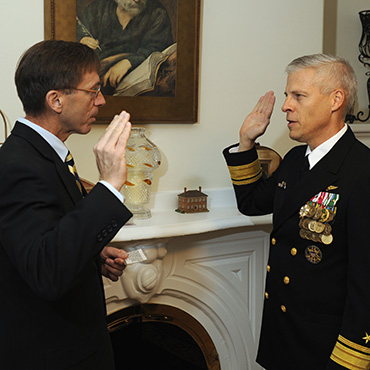Top Navy official asks Congress to strip out acquisition regulations

The new Congress should focus reform efforts on doing away with existing regulations rather than adding new ones, says the assistant secretary of the Navy for research, development and acquisition.

The Navy's Sean J. Stackley, shown here administering the oath of office to Rear Adm. Matthew L. Klunder during a promotion ceremony at the Washington Navy Yard, is urging Congress to trim acquisition regulations, not add to them. (John F. Williams / Wikipedia)
A top Navy official says the new Congress should focus acquisition reform efforts on doing away with existing regulations rather than adding to a process that is already overly complex.
"We need precious little new legislation that will trigger added bureaucracy to respond to new requirements levied against an already byzantine process," Sean Stackley, assistant secretary of the Navy for research, development and acquisition, said Jan. 7 in remarks at the Atlantic Council in Washington, D.C.
The statement reflects growing agreement between Capitol Hill, the Defense Department and industry players that the acquisition process has grown intolerably complex and is undercutting the Pentagon's technological competitiveness with adversaries.
An intra-Pentagon acquisition reform team has spent several months combing existing acquisition regulations in search of burdensome and redundant rules, Stackley told reporters after his appearance. That team, led by the office of the undersecretary for acquisition, technology and logistics, will soon submit its recommendations for reform to Sen. John McCain (R-Ariz.) and Rep. Mac Thornberry (R-Texas), who now chair the Senate and House Armed Services committees. Lawmakers would consider the reforms for the fiscal 2016 defense authorization bill.
Previous House Armed Services Chairman Howard "Buck" McKeon (R-Calif.) tapped Thornberry to tackle acquisition reform, and the new chairman will likely make it a priority for his turn with the gavel.
The reform recommendations the Pentagon submits to Congress will overlap with those provided by the National Defense Industrial Association, a defense lobby with about 1,600 corporate members. NDIA, which sponsored the Jan. 7 Atlantic Council event, undertook a several-month review of the acquisition process and submitted recommendations to the Senate and House panels in November. Among those recommendations was a pilot program to allow capable acquisition professionals to ignore superfluous requirements for acquisition programs. The pilot is meant as a way to circumvent "overly complex acquisition laws, regulations and their enforcement bureaucracy [that] create unclear lines of authority and accountability in program management," the NDIA report states.
Many Defense officials and contractors consider the current Federal Acquisition Regulation to be overly complex --the first volume runs nearly 1,900 pages. Some propose working with current law rather than adding to it. For example, another Navy official has suggested that the FAR be reinterpreted to speed up the acquisition of IT. This might mean labeling IT needs differently to fast-track them in the acquisition cycle. When asked about this option, Stackley told reporters that it was certainly better than waiting for changes to the FAR, saying wryly that it is easier "to get to the moon and back" than to reform the FAR.
During his prepared remarks, Stackley said the mismatch between a tedious and drawn-out acquisition process and the pace at which threats emerge is "unacceptable."
"We also need to up our game in warfare areas where we're falling behind or at risk of falling behind: cyber, electronic warfare, offensive surface warfare," he said.
NEXT STORY: Cyber Command turns to industry for solutions





